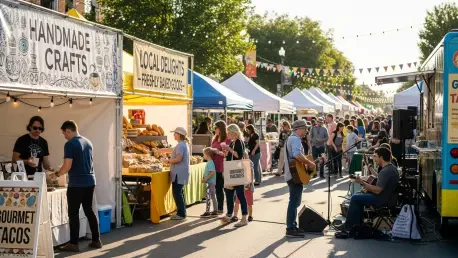Imagine a bustling Sunday in downtown Syosset, where thousands of locals and visitors flood the streets, eager to explore vendor booths, enjoy live entertainment, and savor local food, all while businesses face the challenge of standing out. Amid this vibrant chaos, how does a small business turn fleeting glances into lasting connections? This challenge is at the heart of successful street fair marketing, and the Syosset Woodbury Chamber of Commerce is equipping vendors with proven strategies to seize this opportunity. The annual Syosset Street Fair, a cornerstone of community engagement, offers a unique platform for businesses to shine, provided they approach it with the right tactics.
This guide delves into best practices for street fair marketing, drawing on expert insights shared at a recent Chamber meeting. With actionable advice from industry veteran Ari Goldblatt, vendors can learn how to define clear goals, craft engaging activation plans, manage budgets effectively, and design booths that captivate attendees. These strategies aim to transform a simple booth presence into a powerful tool for brand visibility and customer engagement, ensuring businesses maximize their impact at this high-energy event.
Why Street Fair Marketing Matters
Street fairs like the one in Syosset present a rare chance for businesses to interact directly with a large, targeted audience in a condensed time frame. With attendance often reaching up to 10,000 people, the event offers unparalleled access to potential customers who are already in a festive, receptive mood. This setting is ideal for making an immediate impression that can translate into sales or long-term relationships.
Beyond sheer numbers, live events foster deeper engagement that digital marketing often struggles to replicate. Face-to-face interactions allow vendors to convey passion, answer questions on the spot, and build trust with attendees. These personal connections can elevate a business’s reputation and create a memorable experience that keeps customers coming back.
Moreover, strategic marketing at a street fair can amplify brand visibility in ways that linger beyond the event itself. A well-executed booth presence not only generates leads but also plants seeds for word-of-mouth promotion within the community. By leveraging this platform, businesses can turn a single day into a springboard for sustained growth.
Key Marketing Strategies for Street Fair Vendors
To help vendors make the most of the Syosset Street Fair, Ari Goldblatt, a seasoned live event marketing expert and Chamber board member, shared actionable tips at a recent gathering. His advice focuses on tailoring approaches to the unique environment of a street fair, where competition for attention is fierce. These strategies provide a roadmap for standing out amid the crowd and achieving meaningful results.
Goldblatt’s insights cover a spectrum of critical areas, from setting precise objectives to engaging attendees effectively. Each tactic is designed to address the fast-paced, sensory-rich atmosphere of the fair, ensuring vendors can cut through the noise. By applying these methods, businesses can transform casual passersby into loyal customers or valuable contacts.
The following sections break down these strategies into practical steps, enriched with real-world examples and scenarios. Whether a vendor is new to street fairs or a seasoned participant, these best practices offer guidance to elevate their presence and maximize return on investment at this dynamic event.
Defining Clear Business Goals and Messaging
Before setting up a booth, vendors must pinpoint exactly what they hope to achieve at the Street Fair. Goals might include boosting product sales, expanding professional networks, gathering customer feedback, or simply increasing community awareness. Having a specific target provides direction and helps measure success after the event.
Equally important is identifying the right audience within the diverse crowd and crafting messages that resonate with them. Not every attendee will be a potential customer, so vendors should focus on those who align with their offerings. Clear, concise messaging ensures that interactions are impactful, leaving a lasting impression on the right people.
Real-World Example: Tailored Messaging in Action
Consider a local bakery participating in the fair. By recognizing that families with children form a significant portion of attendees, the bakery shifts its messaging to highlight kid-friendly treats and family baking traditions. This targeted approach draws parents and young fairgoers to the booth, resulting in higher engagement and sales compared to a generic pitch.
Creating an Effective Activation Plan
An Activation Plan goes beyond merely occupying a booth; it’s a deliberate strategy to attract and engage fairgoers actively. This involves creating moments of interaction that spark interest, such as live demonstrations, interactive games, or personalized conversations. The goal is to make the booth a destination rather than just another stop.
A key component of this plan is leveraging one-on-one interactions to build connections. Vendors should also prioritize collecting contact information for follow-up, using tools like contests or sign-up forms. Informing attendees about future outreach ensures transparency and sets the stage for continued engagement long after the fair ends.
Case Study: Lead Generation Success
Picture a financial planner at the Street Fair offering quick, complimentary mini-consultations at their booth. By engaging attendees in brief yet meaningful discussions about financial goals, the planner captures dozens of leads through sign-up sheets for follow-up sessions. This approach not only showcases expertise but also builds a pipeline of potential clients from a single day’s effort.
Budget-First Planning for Cost Efficiency
Goldblatt advocates a “Budget-First Planning Approach” to help vendors manage expenses associated with street fair participation. This method involves listing all anticipated costs—such as tent rentals, signage, and product samples—while including placeholders for unknowns. Such foresight prevents financial surprises and keeps spending in check.
Additional considerations like taxes and delivery charges should not be overlooked, as they can quickly add up. By mapping out a detailed budget early, vendors gain clarity on resource allocation and can make informed decisions about where to invest for maximum impact. Consulting with local experts for cost-effective solutions, like durable signage, further enhances efficiency.
Practical Example: Budget Planning Pays Off
Take the case of a small retailer who meticulously planned their Street Fair budget. By allocating specific funds for high-quality, reusable signage, they created a professional booth setup that stood out without exceeding financial limits. This careful planning allowed them to focus resources on engaging attendees rather than scrambling to cover unexpected costs.
Designing Eye-Catching and Functional Booths
Booth design plays a pivotal role in attracting attention at a crowded event like the Street Fair. Signage, display frames, and overall aesthetics should align with the business’s branding while creating an inviting atmosphere. Thoughtful design elements can draw curious attendees closer, setting the stage for meaningful interactions.
Beyond visuals, functionality matters. Vendors are encouraged to step out from behind their booths to engage passersby directly, rather than remaining passive. Strategically placing giveaways to encourage conversation—rather than easy grabs—ensures that interactions are purposeful and tied to the business’s goals.
Vendor Insight: Memorable Booth Displays
Echoing Goldblatt’s advice, Chamber member Alan Goldberg emphasized the value of proactive engagement. One vendor trained their staff to approach attendees with friendly greetings and key messages, rather than leaving promotional items unattended on a table. This hands-on tactic led to richer conversations and stronger connections, proving that personal effort can outweigh passive displays.
Final Thoughts and Practical Takeaways for Vendors
Reflecting on the insights shared by Ari Goldblatt and the Syosset Woodbury Chamber of Commerce, it becomes clear that preparation and strategy are the cornerstones of success at the Street Fair. Vendors who take the time to define goals, plan activations, budget wisely, and design captivating booths reap the rewards of deeper customer engagement and enhanced visibility.
Looking ahead, businesses are advised to apply these lessons by starting their planning early for future events. Exploring additional resources through Chamber meetings offers a chance to refine tactics and network with peers. Staying connected via the Chamber’s online platform provides ongoing updates and support, ensuring vendors remain equipped for success in upcoming fairs and beyond.









